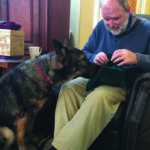Fidelco: Always Moving Forward.
1960s
In the 1960s, the Kamans were breeding German Shepherds in their home kennel, placing them with Puppy Raisers, and then donating them to other guide dog schools for training.
At that time, “force-based” methods (known as traditional methods) were the most common way for trainers to encourage dogs to perform.
Very little, if any, food rewards were used at this time, as it was assumed that dogs would perform out of a willingness to please their handler or an intrinsic desire to perform the behavior requested. These methods were common practice in both the pet dog and guide dog fields.
1980s
It wasn’t until 1980 that the Kamans hired a Director of Training as their first employee. Fidelco trained and placed five guide dogs in 1981, using its pioneering “In-Community Placement” model.
Fidelco’s first breeding, animal care, and training facility was built in 1984.
1990s
Fidelco’s office space and kennel expansion were completed in 1991. During this time, clicker/marker-based training began to gain popularity among dog trainers, and a trend toward gentler handling methods began. This type of training focuses on setting the dog up to be successful by reinforcing the correct behavior as opposed to punishing incorrect behavior.
The guide dog training sector was slower to adapt to the idea of using food rewards and clicker training; it was a common belief that guide dogs should not be trained with rewards for fear it could distract them from their work. The belief also persisted that a person who is visually impaired may not be able to or want to use food rewards.
Throughout the 1990s, Fidelco’s breeding trended toward developing a more sensitive and easier-to-handle dog. With positive training becoming mainstream, Fidelco began to experiment with additional positive-based training methods. Fidelco trainers started using more food rewards, and later began to incorporate marker-based training or “clicker” training into the guide dog training protocol. Trainers also began using head collars such as Gentle Leaders® and Haltis® as an alternative to chain collars. Head halter-type collars are useful in preventing sniffing and are better able to control the dog’s head than a collar around the neck. This gives the handler a little more control without being overly aversive for the dog.
2000s
In the 2000s, Puppy Raisers began using head collars, and trainers continued to find applications for clicker training in the guide dog training protocol. The trainers were also presented with continuing education opportunities that enhanced their understanding of training methods.
In training, dogs are becoming more active participants in their learning and ultimately demonstrate a stronger retention of desired skills. Once a skill is learned, the dog is held accountable; if an incorrect or inappropriate behavior occurs, the trainers use natural consequences to correct the inappropriate behavior. For example, if a dog becomes distracted, the handler may exaggeratedly bump into an obstacle or trip on a curb. This correction is often enough to discourage the dog from getting distracted, and to pay more attention to his work. The trainers will also re-work the skill to give the dog another chance to perform the skill correctly.
Today and tomorrow
We are constantly seeking innovative ways to train dogs so we can meet the changing and unique needs of our clients. Most recently, trainers began including electric vehicles in traffic training because with near-silent engines, dogs must learn to respond to the sight of the vehicle and not merely the engine sound.
We are proud of our relationship with United Airlines which allows us the opportunity to board empty planes with dogs while working on appropriate travel behavior. Advances in equipment provide the opportunity to customize the training experience for our dogs. Like humans, no two dogs are the same.
FUN FACTS
Fidelco guide dogs know approximately 80 commands by the time they are ready to be placed with a client.
“Intelligent disobedience” is an essential skill for guide dogs. This term refers to a guide dog resisting the handler’s command in an effort to make a better decision in a situation that could be dangerous. The concept of “intelligent disobedience” has been part of service animal training since at least 1936.
More Fidelco News
- Donor Spotlight: Harvey & Lewis Opticians
- Client Story: Todd Higgins and “Fergus”
- Volunteer Story: The Helming Family



